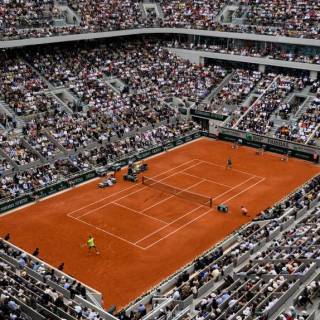The French Open ended with Rafael Nadal lifting his 12th title and Ashleigh Barty her first.
British number one Johanna Konta was an unexpected star with her run to the semi-finals.
Here, we pick out five things we learned from the year's second grand slam.
No stopping Nadal yetAt some point another man will get his hands on the Coupe des Mousquetaires but that moment does not feel like it is getting any closer. Nadal had a difficult build-up to the tournament after more knee problems in the spring but he only lost two sets all tournament and once again quelled the challenge of Dominic Thiem, the pretender to his clay-court crown, in the final. If Nadal's body can hold out, and he rarely seems to struggle on clay, then another couple of titles at least appear a probability.
Thiem's time will comeIt may or may not have been a crumb of comfort for Thiem to hear his conqueror declare him a champion of the future here. Last year's run to the final came with the caveat that Novak Djokovic was not at his best, but here Thiem did what no one had managed for 12 months by beating the Serbian at a grand slam. His ranking of world number four shows that he is more than simply a clay-court specialist and, if he continues to improve at the rate he is showing, then the 25-year-old should have chances to win more than just the French Open.
Variety the name of the gameNo one was more surprised than Barty that it was she who lifted the Coupe Suzanne Lenglen. The Australian had been thought of as a potential grand slam champion on faster surfaces, particularly grass, but not clay. However, what Barty showed with her spins, slices and volleys is that an all-court game can triumph on any surface. Her final opponent, 19-year-old Marketa Vondrousova, also plays with a lot of variety, as does 17-year-old Amanda Anisimova, who made her first slam semi-final. Power no longer trumps all in the women's game, and that is definitely to be welcomed.
Konta is a contender againAnother player who exceeded all expectations was Konta, who had lost all four main-draw matches at Roland Garros prior to this year. She had been a revelation on clay in the run-up to the tournament and played a series of superb matches, particularly her quarter-final victory over Sloane Stephens. The British number one's serve is back to the height of its powers and she no longer relies entirely on her powerfully-hit ground strokes. The striking mental poise she had shown slipped in the semi-finals but Konta loves grass and should look to Wimbledon with optimism for another strong run.
Women deserve respectThe French tennis federation, which runs the tournament, will no doubt breathe a huge sigh of relief that the last edition without a roof on Court Philippe Chatrier is over. Bad weather in the second week gave them a major scheduling headache, and they did not cover themselves in glory with the way they handled it. Putting one women's semi-final on the third court and then delaying the women's final for a men's semi-final sent a message, unintended no doubt, that men's matches were more important. There was no easy solution, but a better one should have been found.
